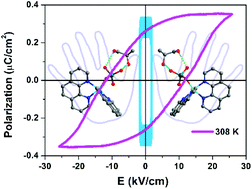当前位置:
X-MOL 学术
›
Inorg. Chem. Front.
›
论文详情
Our official English website, www.x-mol.net, welcomes your feedback! (Note: you will need to create a separate account there.)
Metal–organic ferroelectric complexes: enantiomer directional induction achieved above-room-temperature homochiral molecular ferroelectrics†
Inorganic Chemistry Frontiers ( IF 7 ) Pub Date : 2019-10-21 , DOI: 10.1039/c9qi01197h Yu-Ling Liu 1, 2, 3, 4 , Jia-Zhen Ge 1, 2, 3, 4 , Zhong-Xia Wang 1, 2, 3, 4 , Ren-Gen Xiong 1, 2, 3, 4
Inorganic Chemistry Frontiers ( IF 7 ) Pub Date : 2019-10-21 , DOI: 10.1039/c9qi01197h Yu-Ling Liu 1, 2, 3, 4 , Jia-Zhen Ge 1, 2, 3, 4 , Zhong-Xia Wang 1, 2, 3, 4 , Ren-Gen Xiong 1, 2, 3, 4
Affiliation

|
Ferroelectrics as a class of technically important materials have been eagerly pursued, similarly to the gold rush. In particular, in recent years, molecular ferroelectrics have stood out because of their variable structures and excellent properties. However, the discovery of new ferroelectrics is often random rather than strategically designed. Homochirality provides an important bridging effect between structure and properties, in which homochiral crystals tend to crystallize in polar space groups, increasing the possibility of the integration of homochirality with ferroelectricity. In this study, the strategy of homochirality was utilized to realize ferroelectricity in enantiomorphic metal–organic complex crystals based on a nonferroelectric racemic mixture. Unlike the nonferroelectric racemic mixture, both Cu(1,10-phenanthroline)2SeO4·(R-1,2-propanediol) and Cu(1,10-phenanthroline)2SeO4·(S-1,2-propanediol) adopted the enantiomorphic-polar point group 1 (C1) at ambient temperature and display mirror images, as verified by the crystal structure analysis and vibrational circular dichroism (VCD) spectra. The enantiomers show 2F1-type ferroelectric phase transitions, including a similar phase transition temperature (Tc) and other ferroelectric properties. This finding reveals that the introduction of homochiral molecules provides significant structure-related physical properties crucial for the effective design of homochiral molecular ferroelectrics.
中文翻译:

金属-有机络合物的铁电:对映体定向感应实现上述室温纯手性分子铁电体†
与淘金热相似,铁电作为一类技术上重要的材料也得到了人们的追捧。特别地,近年来,分子铁电体因其可变的结构和优异的性能而脱颖而出。但是,发现新的铁电体通常是随机的,而不是经过战略设计的。同质性在结构和性质之间提供了重要的桥梁效应,其中同质性晶体倾向于在极性空间群中结晶,从而增加了同质性与铁电性结合的可能性。在这项研究中,利用同手性策略在非铁电外消旋混合物的基础上实现对映体金属-有机复合晶体中的铁电。与非铁电外消旋混合物不同,Cu(1,10-菲咯啉)2 SeO 4 ·( R -1,2-丙二醇)和Cu(1,10-菲咯啉) 2 SeO 4 ·( S -1,2-丙二醇)在环境温度下采用对映体极性基团1( C 1)并显示镜像,这已通过晶体结构分析和振动圆二色性(VCD)光谱验证。对映异构体显示2 F 1型铁电相变,包括相似的相变温度( T c)和其他铁电特性。这一发现揭示了同手性分子的引入提供了重要的与结构相关的物理性质,这对同手性分子铁电体的有效设计至关重要。
更新日期:2019-12-18
中文翻译:

金属-有机络合物的铁电:对映体定向感应实现上述室温纯手性分子铁电体†
与淘金热相似,铁电作为一类技术上重要的材料也得到了人们的追捧。特别地,近年来,分子铁电体因其可变的结构和优异的性能而脱颖而出。但是,发现新的铁电体通常是随机的,而不是经过战略设计的。同质性在结构和性质之间提供了重要的桥梁效应,其中同质性晶体倾向于在极性空间群中结晶,从而增加了同质性与铁电性结合的可能性。在这项研究中,利用同手性策略在非铁电外消旋混合物的基础上实现对映体金属-有机复合晶体中的铁电。与非铁电外消旋混合物不同,Cu(1,10-菲咯啉)2 SeO 4 ·( R -1,2-丙二醇)和Cu(1,10-菲咯啉) 2 SeO 4 ·( S -1,2-丙二醇)在环境温度下采用对映体极性基团1( C 1)并显示镜像,这已通过晶体结构分析和振动圆二色性(VCD)光谱验证。对映异构体显示2 F 1型铁电相变,包括相似的相变温度( T c)和其他铁电特性。这一发现揭示了同手性分子的引入提供了重要的与结构相关的物理性质,这对同手性分子铁电体的有效设计至关重要。


























 京公网安备 11010802027423号
京公网安备 11010802027423号